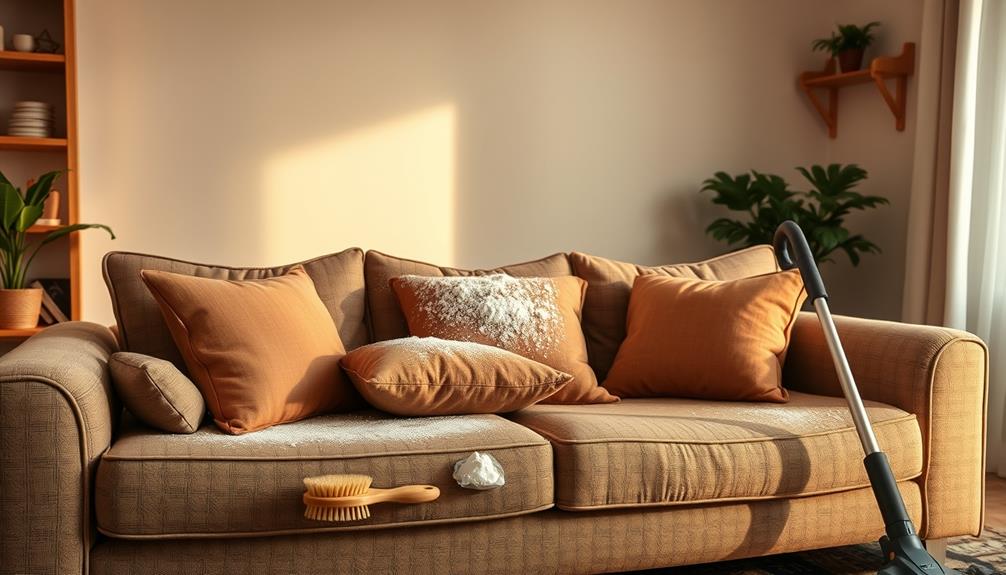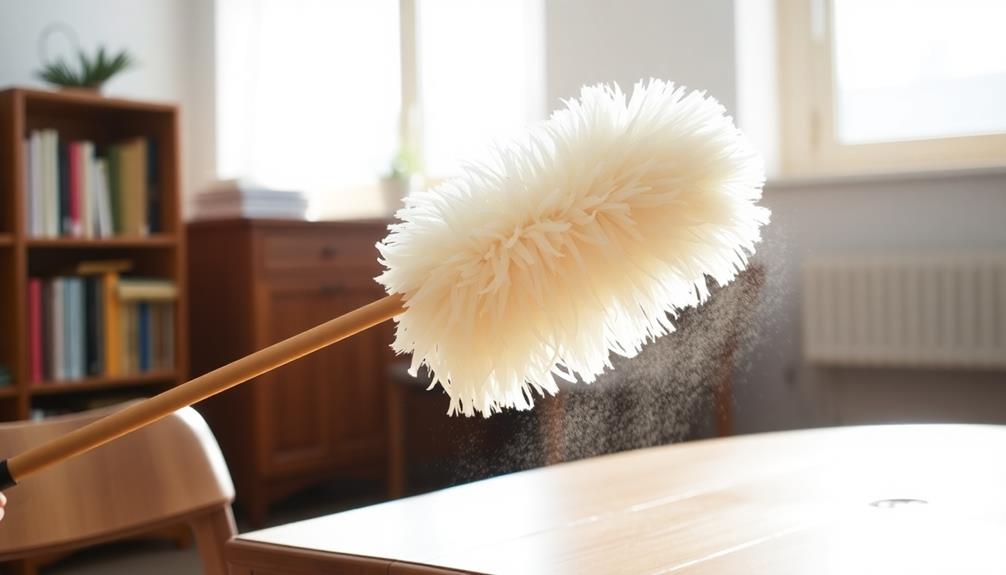To effectively clean your fabric sofa without using water, begin by vacuuming with an upholstery attachment to eliminate any dirt. Before proceeding, it is important to test a dry cleaning solvent on a hidden area to ensure that the color does not bleed. For any stains, gently blot from the edges towards the center using the solvent and a microfiber cloth. To deodorize the sofa, sprinkle baking soda and allow it to sit for approximately 30 minutes before vacuuming it up. Lastly, fluff and brush the fabric to restore its texture. This method will help maintain the appearance of your sofa and prevent damage. If you are interested in learning more about fabric sofa cleaning techniques, there are various resources available online and in books. Additionally, you can seek advice and expertise from professional cleaners. By staying informed and properly caring for your fabric sofa, you can extend its lifespan and keep it looking great for years to come. Remember to always follow the manufacturer’s recommendations for cleaning and maintenance.
Key Takeaways
- Vacuum the sofa thoroughly using an upholstery attachment to remove loose dirt and debris without using water.
- Test colorfastness by applying a small amount of cleaning solution on an inconspicuous area to prevent fabric damage.
- Spot clean stains with a dry cleaning solvent, blotting gently from the edges of the stain inward.
- Deodorize by sprinkling baking soda on the fabric, letting it sit for 20-30 minutes, then vacuuming it up.
- After cleaning, brush and fluff the fabric to restore its texture and appearance.
Importance of Water-Free Cleaning
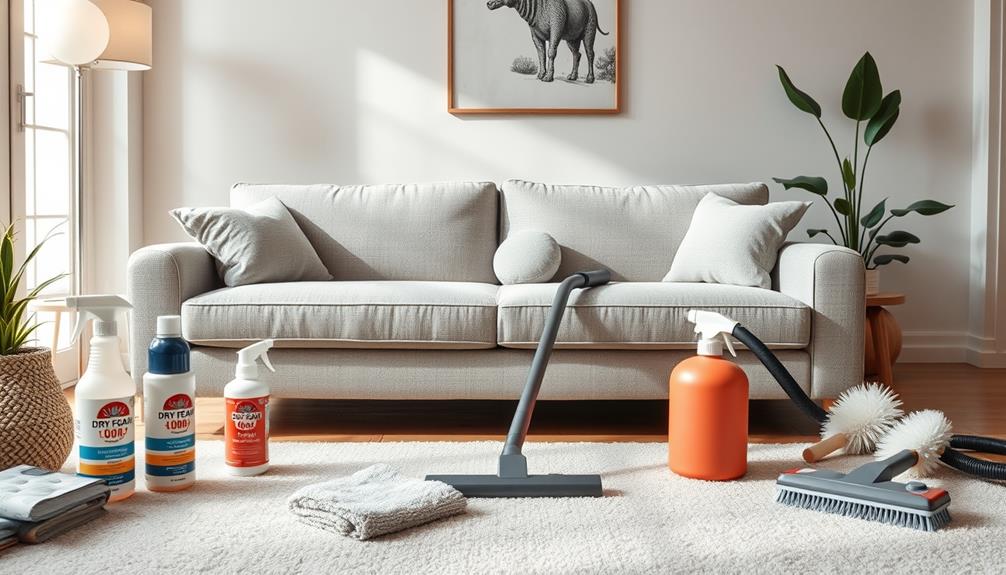
Why is water-free cleaning so essential for your fabric sofa? Using water-free cleaning methods can make a significant difference in preserving your upholstery.
Excess moisture often leads to fabric damage like shrinking, fading, and discoloration. When you introduce water, especially in poorly ventilated areas, you risk mold and mildew growth, which can compromise the integrity of your sofa.
Additionally, it's important to select the right cleaning products to avoid any potential damage to the fabric that may contain harsh chemicals.
By opting for water-free techniques, you not only protect delicate fabrics but also prolong the lifespan of your furniture.
These methods help maintain appearance, ensuring that your sofa looks fresh and inviting. Plus, avoiding water in the cleaning process minimizes the chances of residue buildup, which can attract dirt and allergens over time.
Step-by-Step Cleaning Process
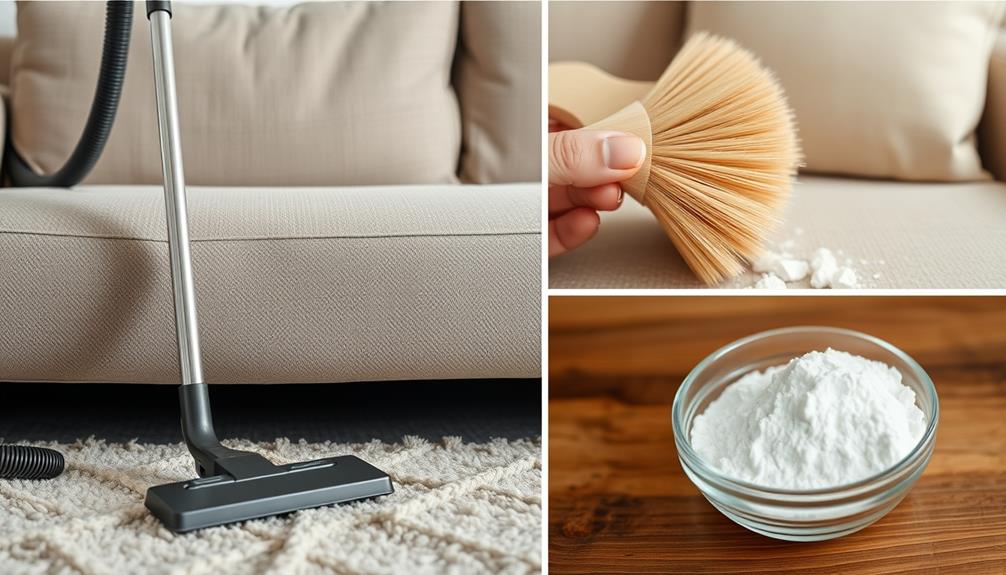
Cleaning your fabric sofa can seem intimidating, but breaking it down into a step-by-step process makes it manageable and effective. Follow these steps to clean upholstery without water:
| Step | Action | Tools Needed |
|---|---|---|
| 1. Vacuum | Use an upholstery attachment to remove loose dirt and debris. | Vacuum cleaner |
| 2. Test Colorfastness | Apply a small amount of cleaner on an inconspicuous area. | Upholstery cleaner |
| 3. Spot Clean | Use a dry cleaning solvent or upholstery cleaner to gently blot stains from the outside edges inward. | Dry cleaning solvent |
| 4. Deodorize | Sprinkle baking soda over the sofa, let it sit for 20-30 minutes, then vacuum it up. | Baking soda |
| 5. Fluff | Brush and fluff the fabric to restore its texture and appearance. | Soft brush |
Common Cleaning Mistakes
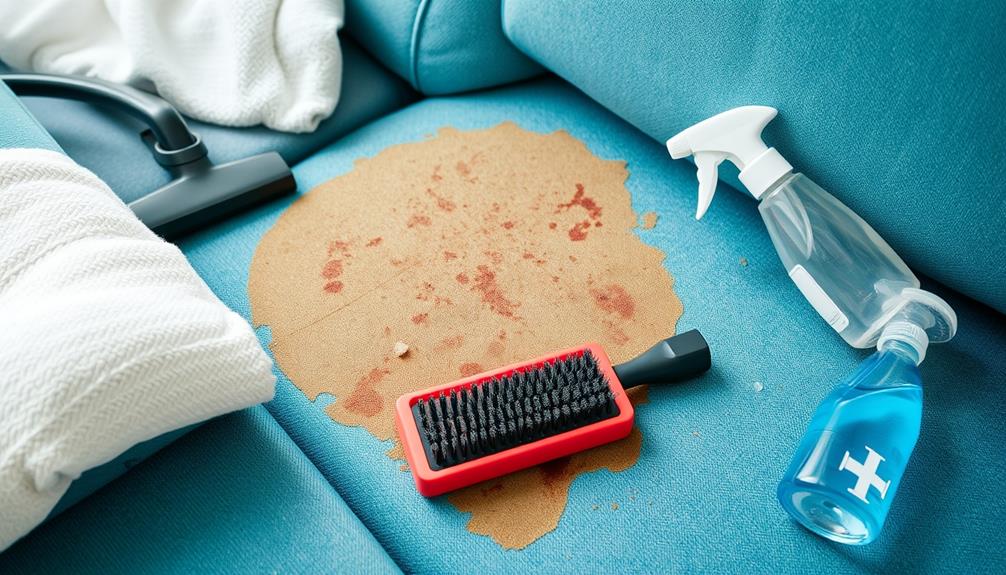
When cleaning your fabric sofa, it's easy to over-saturate the material with solutions, which can lead to moisture buildup and promote mold growth.
You also shouldn't skip the colorfastness test, as applying cleaners without checking can cause irreversible damage to delicate fabrics.
Being mindful of these common mistakes can save your upholstery from costly repairs.
Over-saturation Risks
Over-saturating your fabric sofa with cleaning solutions can lead to significant problems. When you apply too much cleaner, you risk creating moisture buildup, especially in poorly ventilated areas. This excess moisture can lead to mold and mildew growth, which can be challenging to remove.
Additionally, excessive moisture can weaken the fibers of your upholstery, causing irreversible damage and reducing its lifespan. It's also important to note that the right vacuum can assist in maintaining your sofa by effectively removing dust and allergens, especially if you choose from the best vacuums for dust removal in 2024.
You might think vigorous scrubbing will help, but it can actually spread stains further and damage the fabric, compromising its appearance. Always remember to follow the manufacturer's cleaning instructions; neglecting them can exacerbate over-saturation issues and even void any warranties on your sofa.
Before applying any cleaning solution, conduct colorfastness tests. Skipping this step can result in irreversible color bleeding or fading in certain fabrics, ruining your upholstery's look.
To keep your fabric sofa in top shape, use cleaning solutions sparingly, and avoid over-saturation. By doing so, you'll help maintain the integrity of your fabric and prolong the life of your beloved sofa.
Ignoring Colorfastness Tests
Many people overlook the importance of colorfastness tests, which can lead to costly mistakes when cleaning their fabric sofas. Skipping this important step can result in irreversible damage, such as fading or bleeding, especially on upholstery fabrics sensitive to water-based cleaning solutions.
Before you engage in cleaning, always test a small, inconspicuous area with your chosen cleaner. Additionally, understanding how different fabrics react to cleaning agents is significant, as some may require specific care methods, such as those recommended for cold medications.
Here's why colorfastness tests are necessary:
- Prevents fading or bleeding of colors
- Identifies if your sofa's cleaning code allows for water-based solutions
- Saves you from costly repairs or replacements
- Confirms the cleaning method is safe for your fabric type
To conduct a colorfastness test, apply a small amount of your cleaner and watch for any color change or bleeding.
Many upholstery fabrics, particularly those marked with an 'S' cleaning code, are highly sensitive to water damage. Ignoring this essential step increases the risk of creating visible damage that can't be fixed, leaving you with a sofa that looks uneven and worn.
Maintaining Sofa Cleanliness
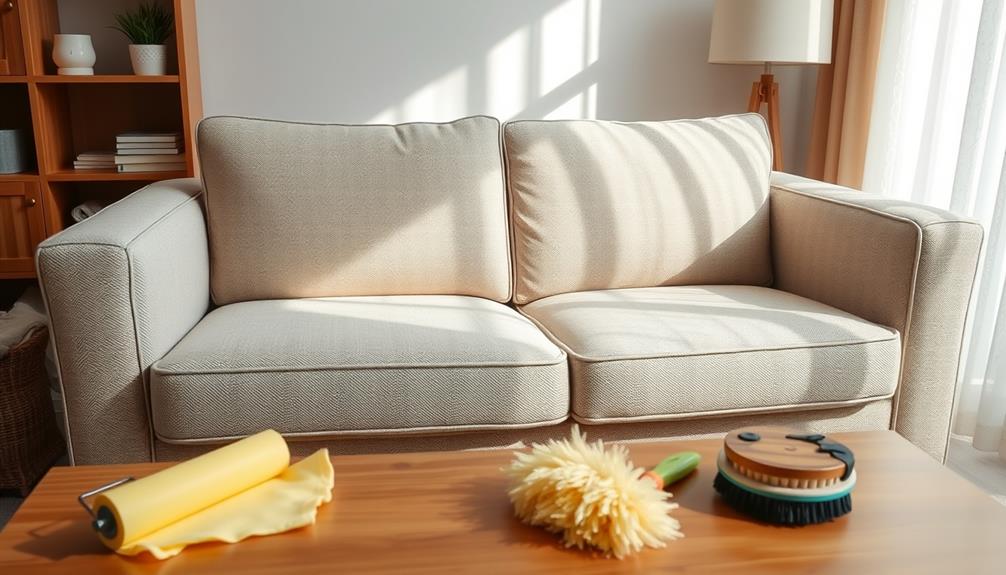
Your fabric sofa deserves regular attention to maintain its cleanliness and prolong its lifespan. Start by committing to regular vacuuming at least once a month. This helps remove dust and dirt, preventing buildup that can affect the appearance and feel of your fabric couches.
Consider investing in appliance maintenance plans to help with cleaning tools and products that can safely clean upholstery. When it comes to spills, treat them promptly with appropriate cleaning methods to avoid setting stains, making future cleaning easier.
To further enhance maintaining sofa cleanliness, rotate cushions and pillows every few months. This promotes even wear and keeps your sofa looking fresh.
Consider using armrest covers to protect high-traffic areas from damage and stains. It's also wise to avoid eating or drinking on the sofa. This simple habit can greatly reduce the risk of spills and odors.
Lastly, schedule thorough cleaning sessions twice a year. These sessions will help preserve your upholstery's appearance and guarantee lasting quality.
Pre-Cleaning Considerations
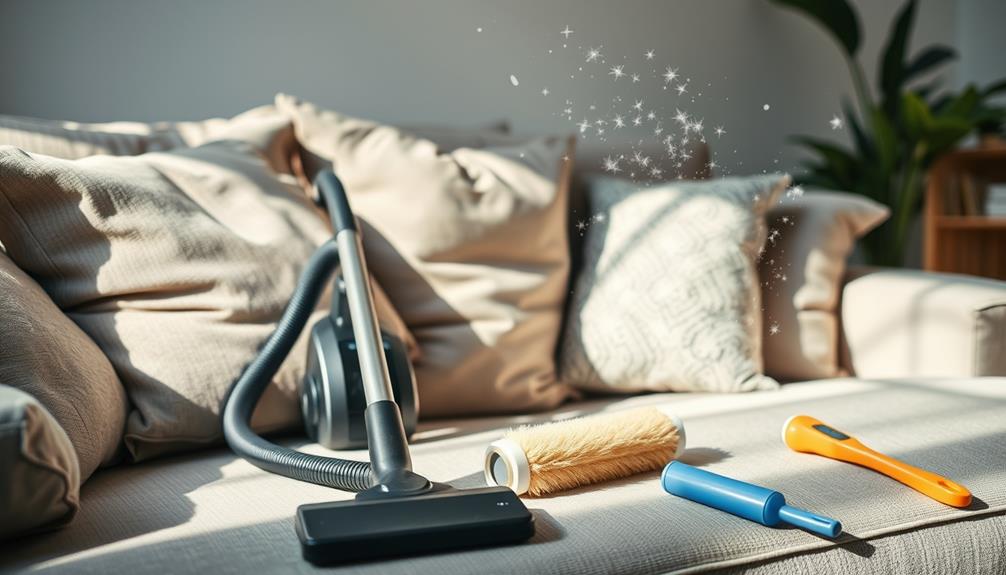
Before you start cleaning your fabric sofa, check the care tag to identify the fabric type. This will guide you on the appropriate cleaning methods to use. Knowing the fabric helps you avoid damage and guarantees the best results.
For instance, some fabrics may benefit from essential oils for cleaning as they can provide natural antibacterial properties.
Additionally, consider testing any cleaning solution on a hidden area to verify it won't affect the color or texture of the fabric.
Identify Fabric Type
Identifying the fabric type of your sofa is essential for effective cleaning and maintenance. By knowing the fabric, you can select the appropriate cleaning methods, helping you avoid damage and keep your upholstery looking fresh.
Start by checking the care tag, which often includes codes like W (water), S (solvent), WS (both), and X (vacuum only). If the care tag is missing, you can perform a test on an inconspicuous area to assess the fabric's sensitivity to water or solvents.
Additionally, understanding proper care techniques for different materials can help prolong the life of your sofa, as highlighted in ultimate hamster care.
Here are some important factors to take into account:
- Different fabrics require different cleaning techniques.
- Using the wrong cleaner can lead to irreversible damage.
- Solvent-based cleaners are suitable for fabrics tagged with 'S'.
- Always test cleaning methods on a small, inconspicuous area first.
Understanding your fabric type guarantees you choose the right cleaning products and methods, preserving your sofa's beauty.
Avoid using water-based cleaners on fabrics tagged with 'S' to prevent issues like shrinking or discoloration.
Check Care Tags
Checking care tags is an essential step in preparing to clean your fabric sofa. These tags provide important information on how to properly care for different fabric types.
You'll find cleaning codes that indicate the best methods: "W" for water-based cleaning, "S" for solvent-based cleaner, "WS" for either, and "X" for vacuuming only. By taking a moment to check care tags, you confirm you're following the manufacturer's instructions, which is imperative for avoiding damage and maintaining any warranties.
Understanding the importance of proper cleaning methods can enhance your sofa's longevity and appearance, similar to how fuel injection cleaning boosts vehicle performance.
Once you identify the cleaning code, you can choose the right cleaning solution and upholstery attachment for your vacuum. If your sofa has an "S" code, you'll want to use a solvent-based cleaner.
Always remember to test any cleaning solution on an inconspicuous area first to prevent potential fabric damage.
Required Tools and Materials
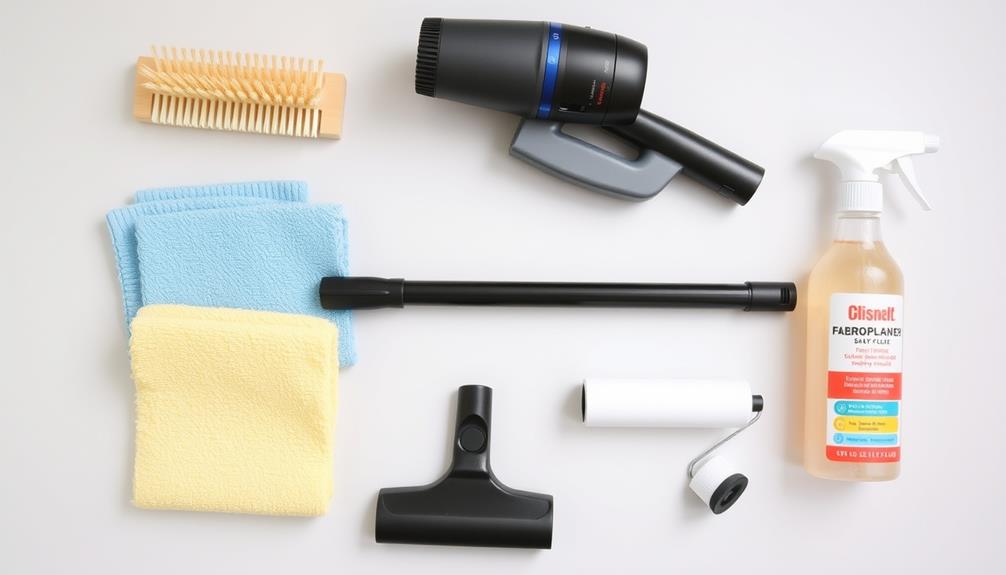
To clean your fabric sofa effectively, you'll need a few essential tools and materials that make the process smoother. Having the right items on hand guarantees that you can tackle dirt and stains without damaging your sofa.
For ideal indoor air quality during your cleaning session, consider using an air purifier maintenance guide to keep the surrounding air clean from dust and allergens.
Here's what you should gather before starting:
- Vacuum cleaner with upholstery attachment: This helps you remove dust and debris efficiently.
- Microfiber cloths: Perfect for dusting and spot cleaning, they won't leave lint behind.
- Soft brush: Ideal for gentle scrubbing without harming the fabric.
- Dry cleaning solvent and baking soda: These are vital for removing stains and odors without introducing moisture.
Additionally, a drop cloth can protect your floor and surrounding areas from any cleaning products or debris.
Don't forget a circulating fan to guarantee good ventilation while using dry cleaning solvents, helping the area dry out quickly.
Always check that all your tools and materials are clean and in good condition before you start to avoid further dirt or damage to your sofa fabric.
With these essentials ready, you're all set for a successful cleaning session!
Effective Cleaning Methods
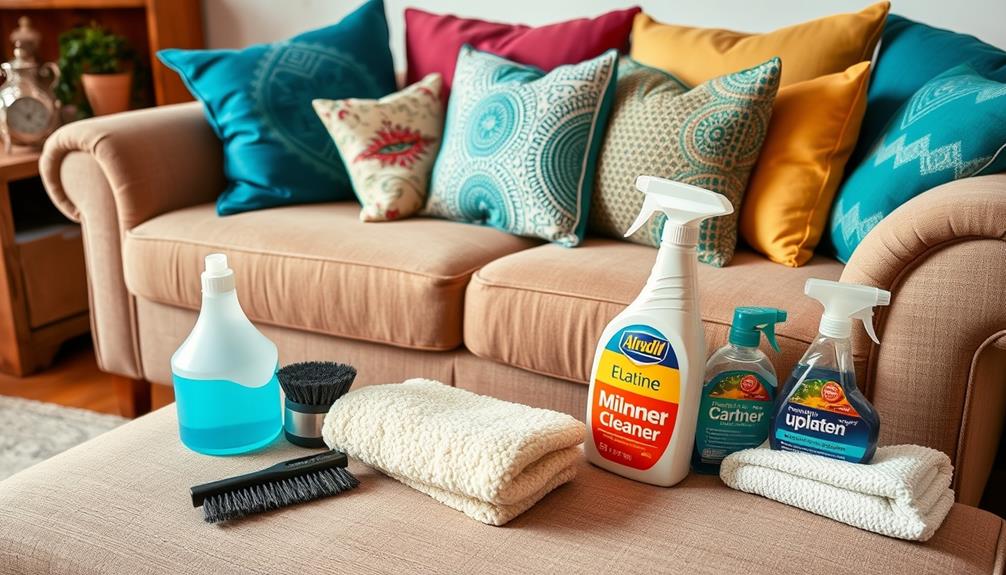
Start by thoroughly vacuuming your fabric sofa with an upholstery attachment to remove loose dirt and debris. This step is essential to guarantee effective cleaning without water. Next, for spot cleaning, use a dry cleaning solvent or upholstery cleaner. Apply it with a clean cloth, gently blotting stains from the edges inward to prevent spreading. Additionally, it’s helpful to regularly rotate cushions and throw pillows to maintain a consistent look and prevent uneven wear. For ongoing maintenance, consider incorporating some sofa cleaning tips for home, such as using a lint roller to pick up pet hair and fabrics softener sheets to eliminate static. Finally, always check the manufacturer’s care instructions before using any new cleaning products to ensure they are safe for your specific fabric.
To eliminate odors, sprinkle baking soda on the fabric and let it sit for 20-30 minutes before vacuuming the sofa to restore freshness. Always remember to test cleaning solutions on an inconspicuous area first to check for colorfastness and avoid fabric damage.
Here's a quick reference table for your cleaning methods:
| Step | Method | Purpose |
|---|---|---|
| 1. Vacuum | Upholstery attachment | Remove loose dirt and debris |
| 2. Spot Clean | Dry cleaning solvent/upholstery cleaner | Treat stains |
| 3. Deodorize | Baking soda | Absorb odors |
| 4. Restore Texture | Brush and fluff | Maintain appearance |
Following these effective cleaning methods will help you clean a fabric couch while maintaining its quality.
Stain Removal Techniques
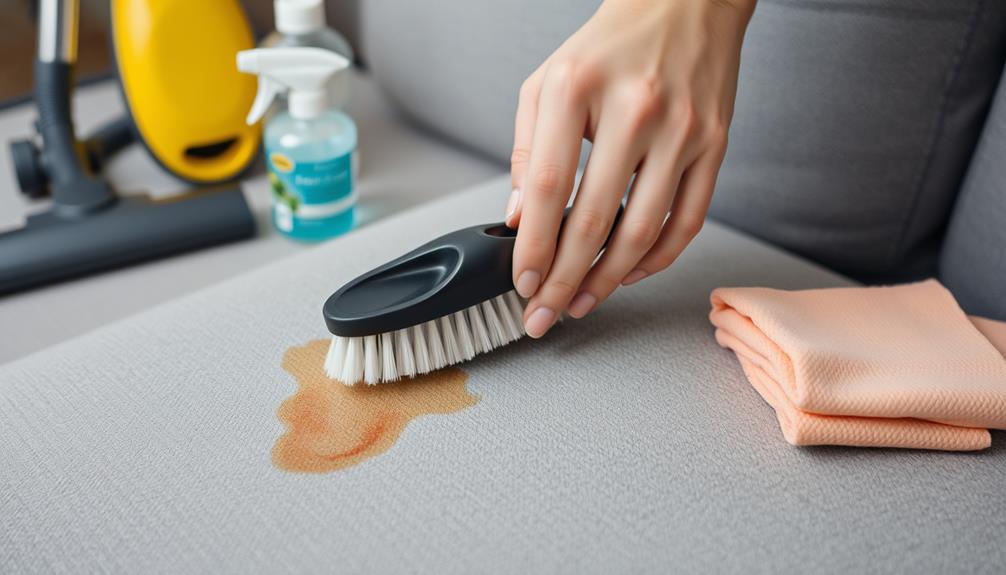
Stains on your fabric sofa can be frustrating, but with the right techniques, you can tackle them effectively.
Using appropriate stain removal techniques will help keep your sofa looking fresh without the need for excess water. Here are some effective methods:
- For food spills, immediately blot the area with a microfiber cloth. Mix 1 teaspoon of dish soap with 2 cups of water, and gently dab the stain without oversaturating the fabric. It's essential to maintain a budget for cleaning supplies to avoid unnecessary expenses.
- To treat oil and grease stains, apply cornstarch to absorb the oil. Let it sit for 15-20 minutes before vacuuming it off. Repeat if necessary.
- Ink stains can be handled by applying rubbing alcohol to a cotton ball and gently blotting the area. Just be careful not to oversaturate the fabric.
- For stubborn water stains, mix ½ cup of white vinegar with 2 cups of distilled water in a spray bottle. Lightly mist the stain, then blot with a microfiber cloth.
Always perform a colorfastness test on an inconspicuous area before applying any cleaning solution to verify it's safe to use on your fabric.
Additional Maintenance Tips
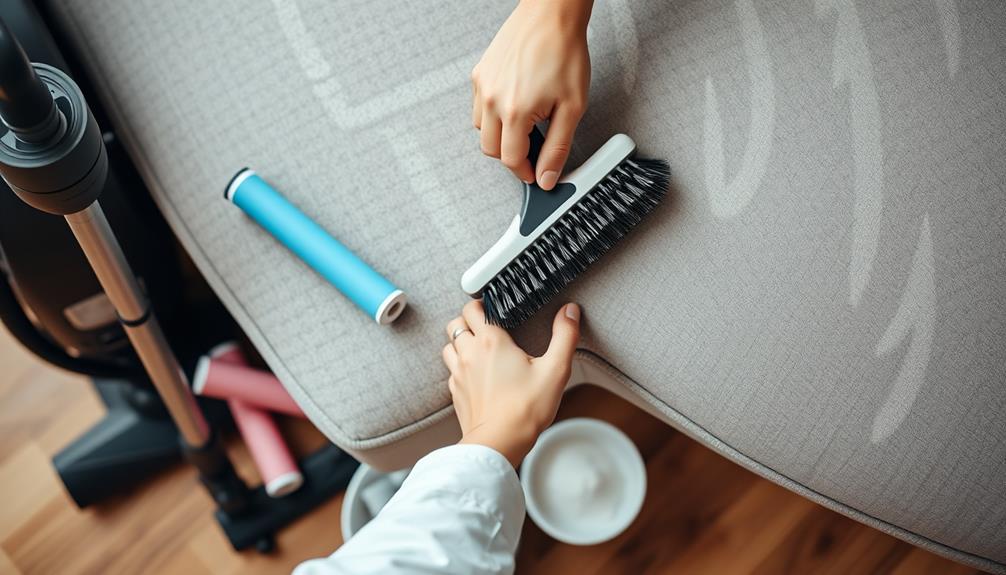
Maintaining your fabric sofa is vital for keeping it looking its best and extending its lifespan. Start by regularly vacuuming your sofa at least once a month to remove loose dirt and debris. This simple practice helps prevent the buildup of grime that can lead to stains.
When you clean a couch, don't forget to rotate cushions and pillows every few months; this guarantees even wear and prolongs your upholstery's life. Additionally, protecting your sofa from potential infection risks and prevention can be significant, especially in households with pets or children.
For those high-traffic areas, consider using armrest covers or throw blankets. They serve as an additional barrier against spills and stains, making maintenance much easier. If you spot clean any areas, use a cleaner with an upholstery-safe formula to avoid damaging the fabric.
It's also wise to schedule deep cleaning services every six months to maintain a fresh appearance and tackle any accumulated dirt or odors.
Frequently Asked Questions
How Do You Clean a Couch Without Wetting It?
To clean a couch without wetting it, vacuum thoroughly, test for colorfastness, spot-treat stains with a dry cleaner, sprinkle baking soda for odors, then brush and fluff the fabric to restore its look.
What Is the Best Way to Clean a Fabric Sofa?
Ever wondered how to keep your fabric sofa looking fresh? Start by vacuuming thoroughly, spot clean stains with a suitable product, and sprinkle baking soda to neutralize odors. Regular maintenance makes all the difference!
How to Clean a Couch That Can't Use Water?
To clean a couch that can't use water, vacuum thoroughly, apply a dry cleaning solvent to stains, and sprinkle baking soda to eliminate odors. Always test cleaning agents on a hidden area first.
Why Should You Avoid Using Water to Clean Upholstery Fabric?
You should avoid using water to clean upholstery fabric because it can cause shrinkage, fading, and mold growth. Keeping moisture away helps maintain your sofa's appearance, ensuring it stays fresh and lasts longer.
Conclusion
Now that you know how to clean your fabric sofa without water, imagine what could happen if you skip these essential steps. Will stubborn stains linger, or will your sofa regain its former glory? The difference lies in your hands. By using the right techniques and tools, you can transform your sofa into a fresh, inviting centerpiece. Don't wait too long—your sofa deserves a makeover, and the results might just surprise you!
